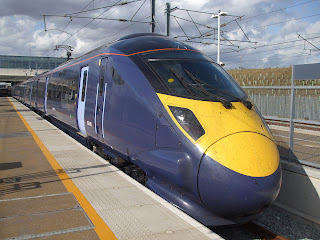Capacitor Buses
Capacitor buses have been primarily developed in the USA and China, the latter country having many cities with very frequent (and overcrowded) bus routes. These electric powered buses charge supercapacitors (AKA ultracapacitors) using an overhead collection system at bus stops. The capacitors can charge very quickly (in minutes), but unfortunately they also discharge very quickly. This currently limits range per charge to a few kilometres. However, longer range versions (30km+) are being developed. Claims have been made from manufacturers of 90% fuel savings compared to diesel buses, as well as being 40% cheaper than lithium ion battery powered buses. Power supply infrastructure has to be installed at charging points. Future developments may include inductive charging, with the charging device under the road instead of above the bus. A YouTube video showing a partial charge is shown below.
Hybrid Buses
With the Toyota Prius being a popular choice for taxis, it is surprising that hybrid buses are not more widespread. The high purchase cost may be a factor. Supercapacitor technology may also make inroads into hybrid buses, with more efficient energy storage from braking to be re-used in acceleration.
Plug-in Electric Buses
There are now a few commercially available buses that charge lithium ion batteries which can power the bus for more than 100km. One of these is the 13 seat Oreos 2X, and 25 seat Oreos 4X from French company Power Vehicle Innovation. Another example is the 8.9m long Urbino Electric from Polish company Solaris. Plug-in electric buses typically require approximately 4 hours per charge, making them potentially unsuitable for all day long use.
Adelaide even has a solar powered electric bus called Tindo. However, the solar panels are placed on the bus station, rather than on the bus, requiring the bus to be charged. Unless solar panel technology can make huge efficiency improvements, then solar powered buses are unlikely to become commonplace.
Hydrogen Fuel Cell Buses
Multiple manufacturers have built more than 100 (in total) hydrogen fuel cell buses for cities around the world, mainly for testing purposes. Hydrogen fuel cells are considerably more energy efficient that internal combustion engines on diesel and gas powered buses. They require hydrogen filling stations, and store the hydrogen in tanks (usually on the roof). Given the CNG bus explosions in Brisbane and Korea, BrizCommuter is a little bit concerned about having hydrogen tanks on top of a bus! As with many other "green" technologies, the overall cost of ownership is currently relatively high. Perth trialled three hydrogen fuel cell buses, the hydrogen being created as a by-product from an oil refinery.
The reality
Apparently a retrofit fast charging electric bus (? technology) which can charge in just 10 minutes is currently being developed for SE Queensland by Varley Electric Vehicles in Virginia, QLD. However the current status of this bus is unknown. Whilst more environmentally friendly than Brisbane's current buses, many of the above technologies may suffer from a higher total cost of ownership. Given the current irresponsible "slash and burn" LNP government, BrizCommuter cannot see these new bus technologies in SE Queensland for the foreseeable future until there are clear economical advantages (which may include local manufacturing), and not just environmental advantages. Supercapacitor buses may well be the first to have economical advantages, and this technology is rapidly advancing. Holding off for longer range versions that only require charging at termini may be sensible.
TransLink do need to take a serious look at the latest offerings of smaller and more economical electric (or hybrid) mini and midi-buses for use of routes with low patronage that does not require a full sized bus. These shorter buses may also find it easier to negotiate some of SE Queensland's anti-bus designed housing developments. However, long charge times are currently a limitation for plug-in electric versions. Holding off for faster charging versions may be sensible.


